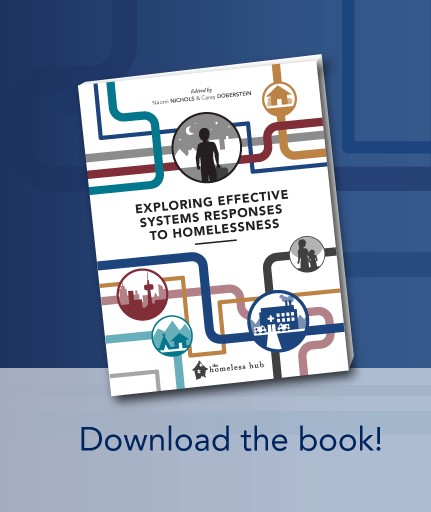Next week, the Homeless Hub and the Canadian Observatory on Homelessness releases a new book, Exploring Effective Systems Responses to Homelessness. The book reflects the collective efforts of people who work in and with the homelessness sector in Canada and internationally. We launched the call for chapters for the book at the Canadian Alliance to End Homelessness (CAEH) Conference in Vancouver in 2014. Just over a year later, we are able to celebrate the publication of this peer-reviewed volume. This publication timeline – unheard of in traditional academic publishing – is a testament to the dedication of all the folks who contributed to the volume as well as the creative energy of the staff at the Homeless Hub.
The production of Exploring Effective Systems Responses to Homelessness feels like a sign of shifting tides. It is no longer the case that academic researchers toil away alone in their offices, producing research for academic journals that most people outside of universities won’t read. The book is also symbolic of what I sense are big shifts in the homelessness sector. Almost a decade ago, I remember people telling me that if you work in housing and homelessness, you operate near the bottom of a symbolic social service hierarchy. Less then ten years later, it isn’t uncommon for people who work in the homelessness sector to bring together institutional decision-makers from other sectors to create collective change. Not only are people who work in housing and homelessness at the table, so to speak, we are setting the tables and inviting others to join in on the action. Nationally, I’ve been amazed to see activists, service providers, and academics have come together in a strategic alliance to end youth homelessness. Across the country, people are working across sectors to create tangible policy changes in support of preventing and ending homelessness through Housing First and other rights-based initiatives. This year, Toronto established the first LGBTQ youth shelter in the province of Ontario and I continue to hear about innovative local efforts to improve service coordination in municipalities across the country (e.g., Comm-Un in Montréal). Clearly, the homelessness and housing sector is leading the change.
I walked away from the Canadian Alliance to End Homelessness Conference in 2015 feeling inspired. As I walked up Montréal’s “Mountain” to my office, I reflected on how the tone and focus of the conference had changed over the last three years and how the energy seemed to be building, rather than waning as one might expect. I wondered how I could translate the collective momentum and spirit of the work of the various Communities, Alliances, Collaborations, and Collectives that have been driving changes in the homelessness sector to similar changes in Education. Education is a sector where research continues not to matter much, and a lack of systems thinking, acting, and planning significantly reduces the impact the sector could make in terms of entrenched patterns of educational and social inequality.
As I walked up that big hill, I tried to figure out what the formula has been in the homelessness and housing sectors, so that I could start to imagine what needs to be done in Education. A distributed approach to leadership clearly matters, as does representative leadership from diverse stakeholders/decision-makers. Vision, daring, passion, hard work – these things also seem to matter. But it seems to me that it is also important that people enjoy working together and that we have grown to trust and respect one another. I will admit that part of my reason for attending the conference each year is to catch up with old friends. This too – our ability to play as hard as we work – seems to be part of what makes us effective as a loose-knit group.
On that note, I’ll end this blog post with a toast: to the work we’ve done together and the work we have yet to do! If anyone wants to help me reform the Education system, drop me a line. I suggest a preliminary brainstorm session over drinks.


